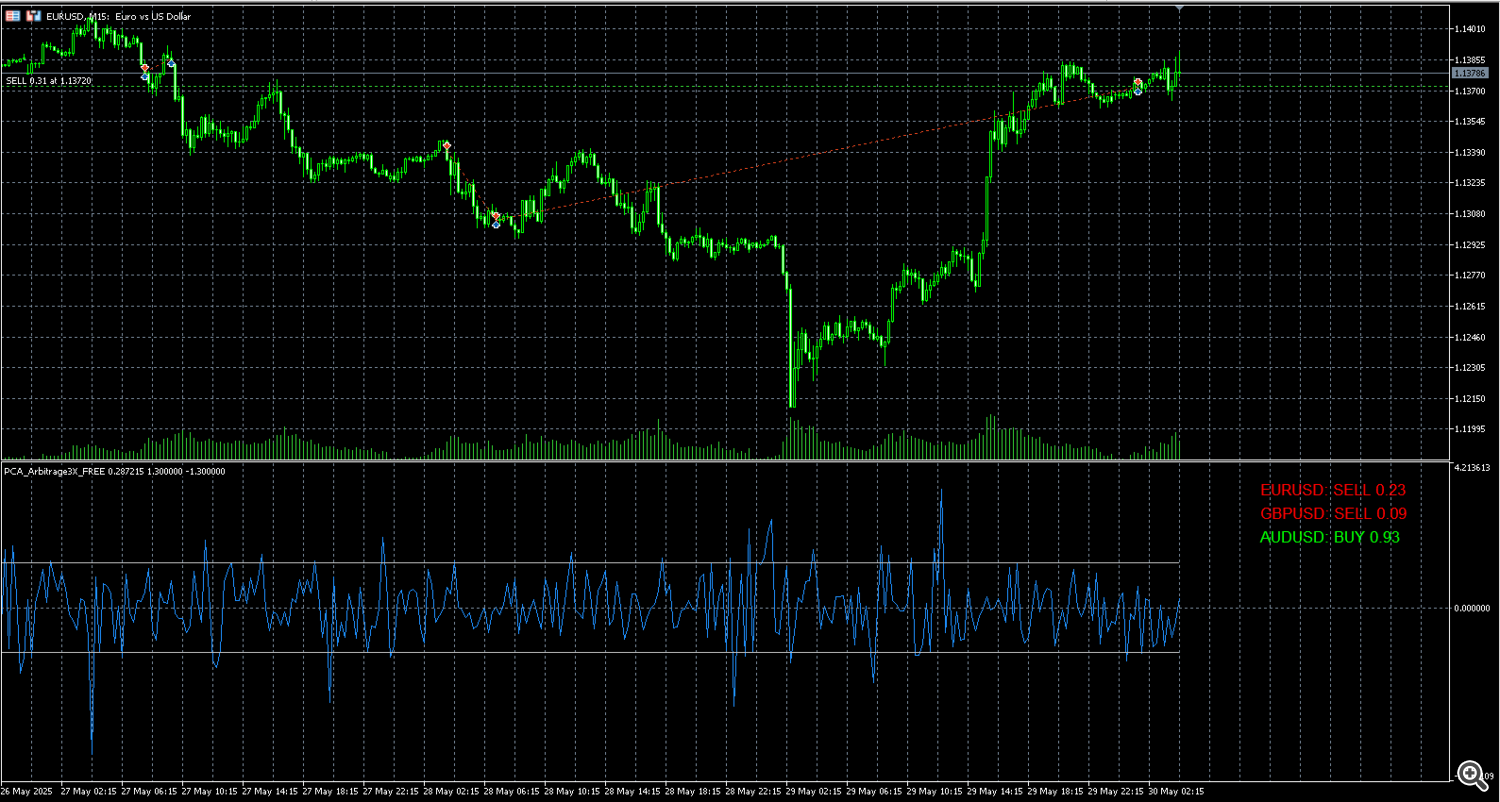
Overcoming Market Noise: How PCA Method Transforms Trading Strategies and Risk Management.
Introduction
The Principal Component Analysis (PCA) method was originally developed for processing multidimensional data. In financial markets, it helps to uncover hidden factors that influence the movement of diverse assets and assess their interrelationships. Within the context of trading strategy development, PCA transforms sets of covariant signals—such as logarithmic returns—into a few independent (orthogonal) components that explain the majority of overall volatility. This approach enables retail traders to eliminate redundant information, reduce multicollinearity, and ultimately build more robust hedging strategies based on positions that are “neutral” to dominant market factors.
The PCA Arbitrage3X EA Expert Advisor, which implements the PCA method, builds its logic on statistical analysis of historical data. It calculates the covariance matrix, performs centering and standardization, and then derives eigenvalues and eigenvectors using specialized algorithms (e.g., the Jacobi method). The EA computes a value referred to as "Score2", which is used to make trading decisions.
Why PCA in Volatile and Correlated Markets?
In environments characterized by high volatility, market noise, and asset correlation, classical technical indicators often lose their effectiveness. Most strategies built on simple signals like RSI, MACD, or moving averages fail to account for inter-asset relationships and the structure of joint movements.
Principal Component Analysis (PCA) is a statistical tool designed to extract the most significant directions of movement from multidimensional data. In finance, PCA reveals the hidden structure of asset relationships and enables the creation of market-neutral baskets. We’ll explore how a retail trader can leverage PCA in automated trading through an EA that embodies this methodology.
Applying PCA in Practical Retail Trading
Identifying Hidden Factors & Neutral Hedging
By applying PCA, traders can isolate components that account for the largest variance in data. For instance, if you have three correlated assets, PCA can determine the combination of returns that results in minimal volatility—effectively neutralizing exposure to broad market movements. The EA implements logic to calculate a Score2 value that signals entry opportunities when the dominant factor (anomalous variance deviation) moves beyond a defined range.
Example:
A retail trader working with indices like US30, USTEC, and S&P 500 can use PCA to build a strategy that simultaneously opens a long position in one index and short positions in the others, forming a neutral basket. This setup minimizes exposure to general market movements, allowing the trader to focus on arbitrage opportunities between the basket components.
Advantages Over Traditional Technical Analysis
Extraction of Meaningful Information:
Unlike most technical indicators that rely on historical prices or volume, PCA uncovers hidden correlation structures. This allows you to understand the underlying relationships between assets, not just follow surface-level trends.
Independence from Time Lag:
Standard indicators like moving averages or oscillators often lag behind real-time market changes. PCA, on the other hand, relies on statistical properties of the data, enabling quicker detection of shifts in asset relationships.
Balanced Risk Distribution:
PCA-based baskets reduce risk exposure to systemic market movements. For example, if one asset experiences a sharp move due to external news, the balanced structure of the basket can help absorb that shock through opposing positions in other assets.
Assets and Use Cases for PCA in Trading
The PCA method can be effectively applied across a range of asset classes:
-
Forex:
Highly correlated currency pairs can be used in hedged strategies, where PCA-derived weights help limit directional risk. For example, combining EURUSD, GBPUSD, and AUDUSD allows for constructing baskets with more evenly distributed exposure.
-
Equities:
Indices, ETFs, and individual stocks can be grouped into PCA-informed baskets. This allows for the creation of market-neutral portfolios where volatility is reduced via cross-hedging.
-
Cryptocurrencies:
Despite their high volatility, crypto markets can benefit from PCA by revealing hidden patterns between tokens. This supports algorithmic arbitrage between correlated coins.
Portfolio Construction & Risk Management Using PCA
The PCA Arbitrage3X EA can serve as a building block for larger portfolios. Each basket represents a neutral strategy across a group of highly correlated assets. To manage capital effectively, consider the following risk control techniques:
-
Capital Allocation per Basket:
Predefine the maximum risk per basket (typically as a percentage of account balance), and use proportional normalization to ensure total exposure stays within limits. For example, if the total risk is capped at 10%, each basket might receive 1.5%–2.5%, depending on volatility and correlation. -
Stop-Loss and Take-Profit Controls:
Define fixed profit/loss thresholds for each basket and establish a total portfolio risk parameter. Use automatic basket closure when cumulative gain or loss hits the target. -
Strategy Diversification:
Use different asset sets and timeframes to create diversified baskets. Allocation across these baskets helps smooth volatility and buffer against temporary market shocks. -
Adaptive Lot Sizing:
As seen in the PCA Arbitrage3X EA, lot sizes are calculated using weight determination, ATR-based volatility adjustments, and normalization. This enables dynamic position sizing in response to changing market conditions—a key feature for effective capital management.
Proof of PCA Method Superiority
Scientific Foundation:
PCA is widely used in econometrics and financial engineering for dimensionality reduction and risk factor modeling. Studies show that PCA components explain a significant share of market volatility, supporting more accurate asset behavior forecasts.
Real-World Validation:
Market-neutral strategies based on statistical models, including PCA, are routinely employed by institutional investors to reduce systematic risk and enhance returns.
Comparison to Traditional Indicators:
Indicators like RSI, MACD, and moving averages rely on lagging data and ignore the market's multidimensional structure. PCA, in contrast, analyzes multiparametric relationships, enabling traders to uncover hidden correlations and adapt to evolving market dynamics.
Conclusion
Principal Component Analysis (PCA) is a powerful tool that empowers retail traders to move beyond basic technical analysis and embrace deep statistical modeling. The algorithms implemented in the PCA Arbitrage3X EA allow for the construction of neutral, balanced asset baskets, reducing systematic risk and improving hedging efficiency. A wide array of assets—from forex pairs to ETFs and cryptocurrencies—can be processed using PCA to build resilient portfolios.
With proper capital management and modern risk control techniques (e.g., basket allocation, adaptive lot scaling, individual risk parameters), a PCA-based strategy can offer robust account protection and efficient capital distribution amid volatile markets. Backed by academic research and real-world application, this approach gives traders a decisive edge over strategies based solely on traditional technical indicators.
This methodology can become the foundation for sophisticated portfolio construction, where each trading direction is managed at the basket level, and overall risk and capital efficiency are continuously optimized. Thus, applying PCA opens new frontiers for retail traders pursuing scientific and modern capital management strategies.



